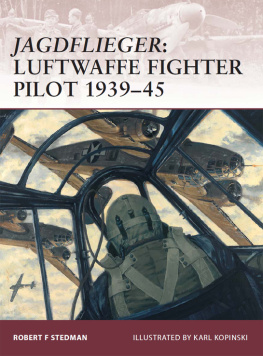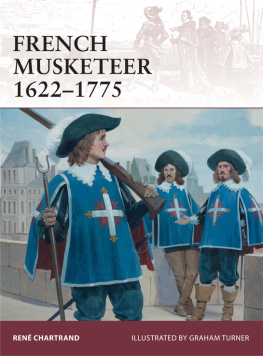Warrior 99
Kampfflieger: Bomber Crewman of the Luftwaffe 1939 45
Robert Stedman Illustrated by Adam Hook
CONTENTS
KAMPFFLIEGER: BOMBER CREWMAN OF THE LUFTWAFFE 193945
INTRODUCTION
T he death of Generalleutnant Walter Wever in June 1936 effectively sealed the fate of the Luftwaffe bomber arm. As Chief-of-Staff, Wever foresaw the need for a long-range Luft-operationsarmee (strategic air army) capable of destroying an enemys industrial heart. His successor, Albert Kesselring, instead evolved a vast fleet of general-purpose medium bombers, functioning primarily in the operational role. This was a kind of tactically strategic force, intended only to cripple enemy communications, supply lines and industry just long enough to influence the outcome of a specific offensive.
The purely tactical operations would be covered by the Sturzkampfflugzeug (dive-bomber), in which the high command invested near total faith. High-altitude bombing was considered costly and imprecise, with much, if not all, of the bomb load falling wide of its intended target (as later evidenced by the comparatively messy Allied bombing patterns). The Stuka offered far greater accuracy in return for a modest outlay in aircraft, ordnance, fuel and personnel, and almost eliminated the risk of damaging non-military areas. Convinced of its war-winning properties by operational trials in Spain, the Reichs Luftfahrt Ministerium (air ministry) cancelled all long-range bomber developments in favour of the Stuka. Dive capability became a prerequisite of all future bomber designs, and was eagerly applied to anything that might be capable of withstanding such extreme manoeuvres; even existing heavy-bombers were modified and tested, often with predictably tragic results. Consequently, the Kampfgeschwadern (bomber squadrons) were only ever equipped for rapid, but ultimately unsustainable, victory.

If I were to depict the face of a Hun airman I should paint a half-witted, leering, vicious face, chosen from the denizens of a lunatic asylum, roaring with laughter as it tosses out its missileswords attributed to Archbishop Partridge of Portsmouth, inDer Adlermagazine, 1940. In reality the LuftwaffeKampffliegerwas little different from his Allied counterpart. Far from home and missing his family, he too served his country, simply hoping to get through it all.
Kampfflieger(bomber crewman)
Typically aged 1821, the earliest recruits were drawn from military families of good breeding, usually the sons of Prussian career officers. Other promising recruits came from army and naval training academies. Officer-cadet Hajo Herrmann was personally invited by Gring himself (while mounted on horseback), as he crawled through an infantry exercise
in 1935. Once the nucleus was formed, anyone who displayed the necessary level of intelligence, commitment and initiative was considered, regardless of background. This particular branch of the Wehrmacht (armed forces) attracted men of all social, educational and economic backgrounds, from shoemaker to count. While each was shaped by his own unique circumstance, experiences and decisions, they shared a common thread in their desire to fly. While some were immediately captivated by bombers, a large proportion had initially dreamed of becoming fighter pilots. Those found temperamentally unsuited to this vocation were instead redirected to train on multi-engine types. Although initially a disappointment, this was in fact a great compliment to their technical skills. The Luftwaffe saw the bomber arm as the true key to victory, and the best recruits were thus guided to this elite corps. The fighter pilot was an inventive, perhaps impulsive flyer, while service as a bomber crewman demanded a far more deliberate and calculating approach. They soon came to appreciate and enjoy their more interesting tasks.

Kampfflugzeugcrew, c. 194041. The need for spectacles initially eliminated a mans chances of aircrew service, but wartime needs led to a very slight relaxation in this ruling. The fact that the observer, an Oberleutnant, greatly outranks the Unteroffizier pilot may seem surprising, but such combinations were not uncommon.
Some aspired to command, while others were just happy to fly in whatever capacity they could. Whatever their motivation, and however they got there, these highly skilled and versatile men formed the very backbone of the offensive air arm and took great pride in the fact that they were Kampfflieger.
CHRONOLOGY
| 1 March 1935 | Luftwaffe publicly announced, new uniform adopted. |
| 13 August 1936 | First bombing, two Ju52s damage Spanish Republican cruiser Jaime I. |
| JanFeb 1937 | Debut of Do17 and He111 with Legion Condor. |
| February 1938 | Debut of Ju87, attack Teruel, Spain. |
| 1 May 1939 | Kampf- and Stukageschwadern raised from existing Gruppen. |
| 26 September 1939 | Debut of Ju88, attack on HMS Ark Royal and Hood. |
| 13 August 1940 | Adler tag (Eagle Day), campaign to destroy RAF. |
| 30 August 1940 | Ju87 withdrawn from Kanalkampf due to unacceptable losses. |
| December 1940 | Arrival in Mediterranean. |
| 16 January 1941 | Bombing of Malta begins (becoming the most bombed area on earth). |
| 6 April 1941 | Operation Marita, simultaneous invasions of Yugoslavia and Greece. |
| 31 May 1941 | Accidental bombing of Dublin. German government later pays compensation to Eire government. |
| 22 June 1941 | Operation Barbarossa, the invasion of Russia, is launched. |
| 23 April 1942 | Retaliatory Baedeker raids commenced against historic British cities following Lbeck raid. |
| 28 June 1942 | Operation Blau, advances into Sevastopol, Caucasus and Don regions. |
| July 1942 | Debut of only four-engine long-range bomber, He177. |
| 5 July 1943 | Operation Zitadelle, the Kursk offensive, begins. |
| 21 January 1944 | Operation Steinbock, limited reprise of campaign against Britain. |
| 21/22 June 1944 | 200 He111s of KG53 and 55 destroy 47 USAAF bombers and 15 fighters on Poltava airfield, Russia, following Berlin shuttle-raid from UK. |
| December 1944 | Debut of worlds first jet-bomber, Ar234. |
| 7 March 1945 | Ar234s commence ten-day attack on Remagen Bridge. |
RECRUITMENT AND ENLISTMENT
Politics undeniably played a major role in the lives of everyone in 1930s Germany (insofar as they could hardly be avoided or ignored), but contrary to Hitlers claim of having a National Socialist air force, the average Kampfflieger held little or no particular interest in such matters, outside their immediate effect upon his family and way of life.
Having been completely dissolved after the First World War, the Luftwaffe had nothing to inherit from the old Reichswehr, and so this branch of the armed forces naturally had to be regenerated under government sponsorship. In that respect, it was indeed a National Socialist air force, but few men joined for political reasons. Whether they condoned, despised or were ambivalent toward Nazi policies, most believed that the NSDAP (


















